This DIY walking tour of Skopje’s historic marketplace, Stara Carsija, shows you the best things to do in Old Bazaar Skopje – including what to eat, where to shop, and what to buy.
When I first arrived in Skopje, North Macedonia’s quirky yet loveable capital city, I was under the impression that I could wander the historic Old Bazaar in an hour or two then check it off my list.
Not true!


Skopje Old Bazaar is huge – it was actually the second biggest Ottoman bazaar of its kind in Europe in its heyday (after the Grand Bazaar in Istanbul, of course).
And it’s far more than just market stalls and shops. Skopje Old Bazaar also encompasses galleries, mosques, museums, restaurants and bars, and all kinds of fun and interesting attractions.
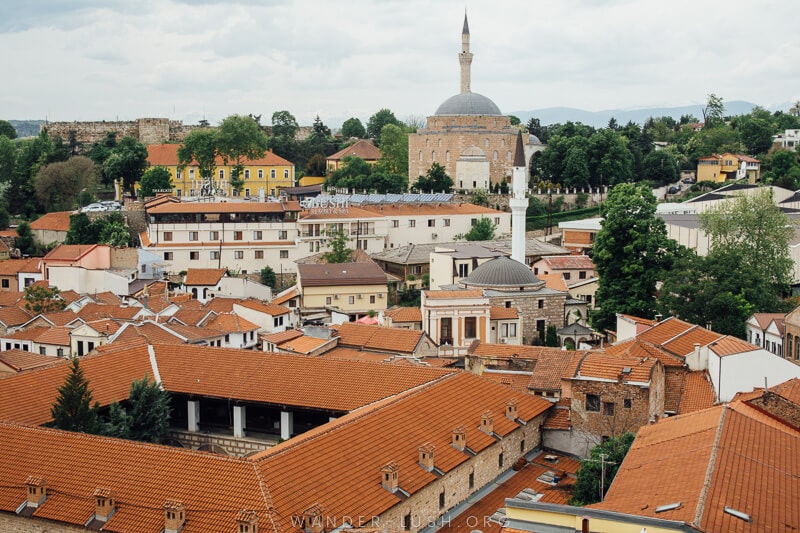
The Old Bazaar is the oldest, most historically important and most atmospheric part of Skopje. Most of the sites that tell the story of the city’s development are located within the Old Bazaar’s boundaries. It’s very much the domain of locals and doesn’t have the same over-touristic feel as some other marketplaces in the region.
This post will tell you everything you need to know about visiting Skopje Old Bazaar, including the best shops, the best views, where to eat, what to buy, and all the best things to do in Skopje Old Bazaar and the surrounding area.
Also read: My curated guide to the best things to do in Skopje & my North Macedonia 7-day itinerary.
Please note: This post contains affiliate links, meaning I may earn a commission if you make a purchase by clicking a link (at no extra cost to you). Learn more.
History of Skopje Old Bazaar
Skopje Old Bazaar dates back to the 12th century, making it the oldest marketplace in the Balkans and one of the original trading hubs in Europe.
The Bazaar was developed by the Ottomans and reflects the Ottoman style of urban planning, where a marketplace would be coupled with mosques, han inns, medresa schools, and other civic buildings.
Also read: Visiting Tetovo’s Painted Mosque as a day trip from Skopje.
The Old Bazaar occupies a huge portion of inner-city Skopje. It’s located on the eastern bank of the river, extending from the foot of Skopje Fortress all the way to the riverfront.
Inside, the bazaar is a maze of oddly shaped city blocks, covered bezisten market areas, and narrow stone alleys that occasionally open out into broader streets and public squares.
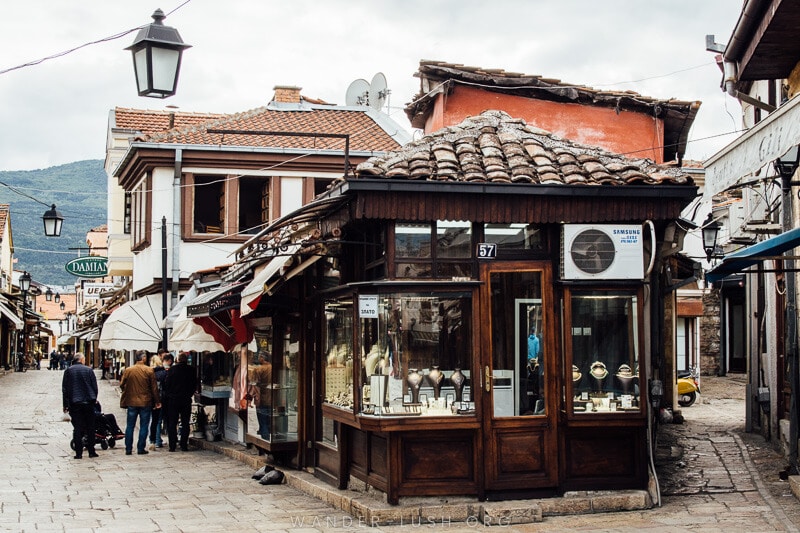
Skopje Old Bazaar predates North Macedonia‘s time under Ottoman rule, but it was the Turkish who gave the bazaar its form and feel.
They centralised trade, organised stalls and added mosques, imarets (public eating houses) and other buildings to the bazaar complex. Trade flourished, and by the 16th century, Skopje was known throughout the region as an important trading hub.
Muslims, Christians, Jews, and visiting merchants from as far away as Dubrovnik, all traded in the bazaar, bringing their trades and products with them.
Since the 1960s, the bazaar has changed significantly. It’s now widely considered the domain of Skopje’s Albanian population.
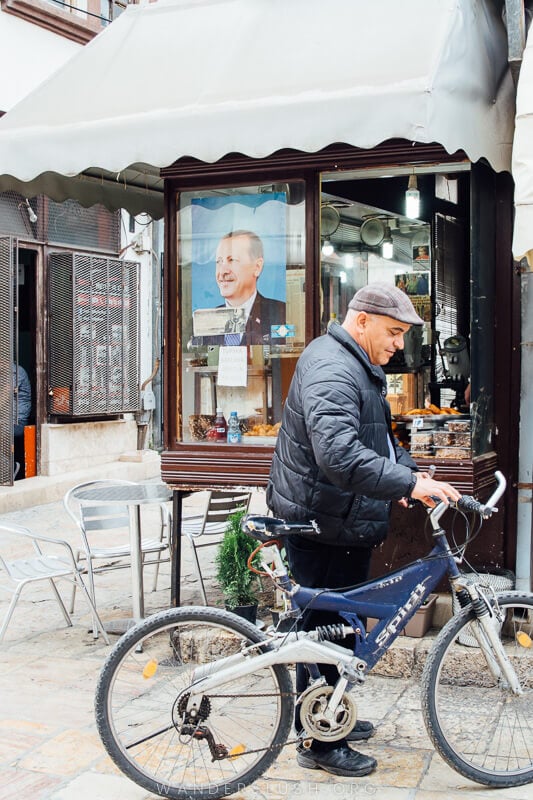

Old Bazaar Skopje: Visitor’s info
- Location: The Old Bazaar is located on the eastern side of Skopje, bounded on one side by the river and stone bridge, and fortress on the other. On its northern edge, the bazaar bleeds into the Bit Pazaar, Skopje’s biggest fresh food market.
- Opening hours: The Bazaar area is open 24/7. Most shops raise their shutters by 8am and stay open until late (at least sunset). Some shops holders take a break in the middle of the day for lunch. Museums and the fort have their own opening hours (outlined below). Restaurants and cafes are open all day for breakfast, lunch and dinner.
- Best time to visit: A great time to visit is mid-morning, when people are out shopping and before the heat of the day sets in. Bit Pazaar is full of produce in the morning and closes up after lunch. Late afternoons in the Skopje Old Bazaar are also lovely.

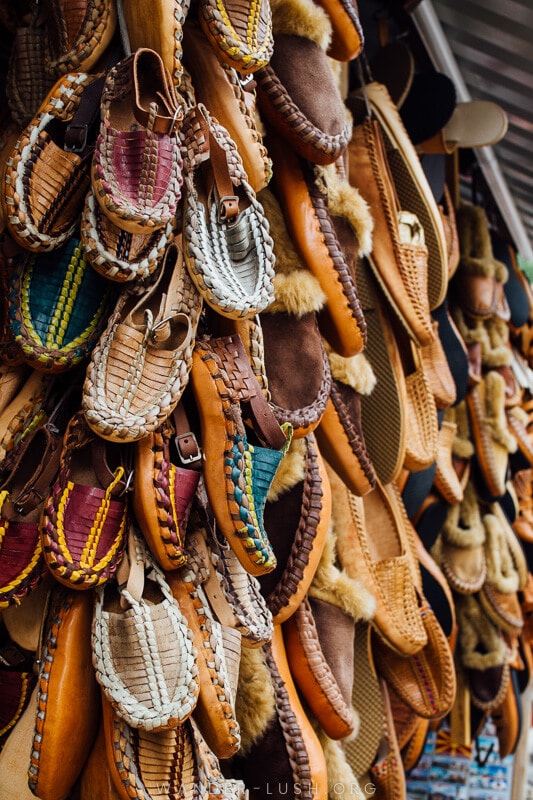
What to buy in Skopje Old Bazaar
One of the highlights of visiting Skopje’s Old Bazaar is doing a spot of shopping. Although most of the traditional tradespeople have left, their ateliers replaced with souvenir stalls and antique shops, there are still a few craftspeople working in the bazaar.
One of them, Skopje’s hatter, will warmly welcome you into his shop and show you around!
Here are some of the notable local products to look out for in the Bazaar:
- Honey (the last woman wild beekeeper in Europe sells her honey here!)
- Silver filigree (watch my video from Prizren, Kosovo to see how filigree is made)
- Carpets, kilims and traditional costumes
- Painted clay pottery
- Leathergoods (especially Opanci ‘peasant shoes’)
- Communist-era antiques and military memorabilia
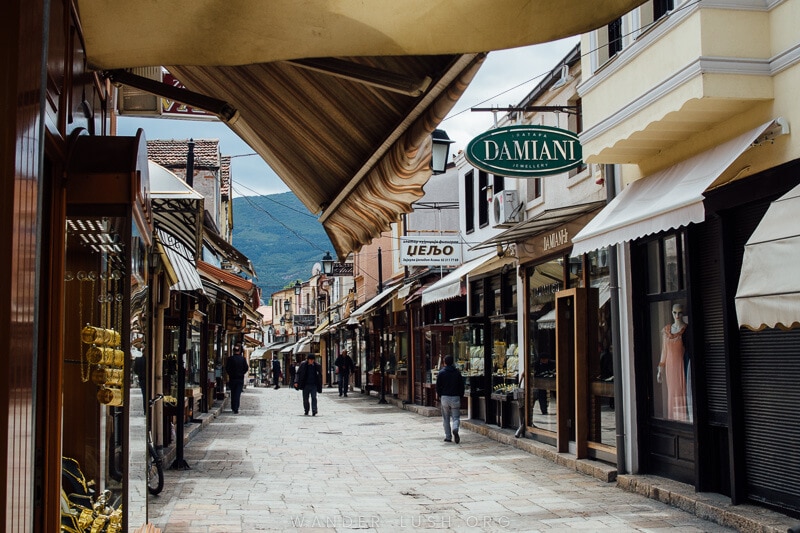
Self-guided walking tour of the Old Bazaar & surrounds
This DIY walking itinerary starts at the Stone Bridge and finishes at Kale Fortress. I suggest visiting the bazaar in the afternoon so you can finish with sunset at the fortress.
I walked this exact route myself, and it took me approximately 3-4 hours with plenty of stops for photos and coffee.
I’ve tried to include all the major points of interest in this itinerary. But the absolute best thing to do in Skopje Old Bazaar is get lost in the backstreets. Use this itinerary as a guide, but I encourage you to go off the path and discover some of the bazaar’s secrets for yourself!
And don’t forget to check out the newer side of the city and some of the outer suburbs, too. If you’re looking for more inspiration, this Skopje city guide is a good place to start.
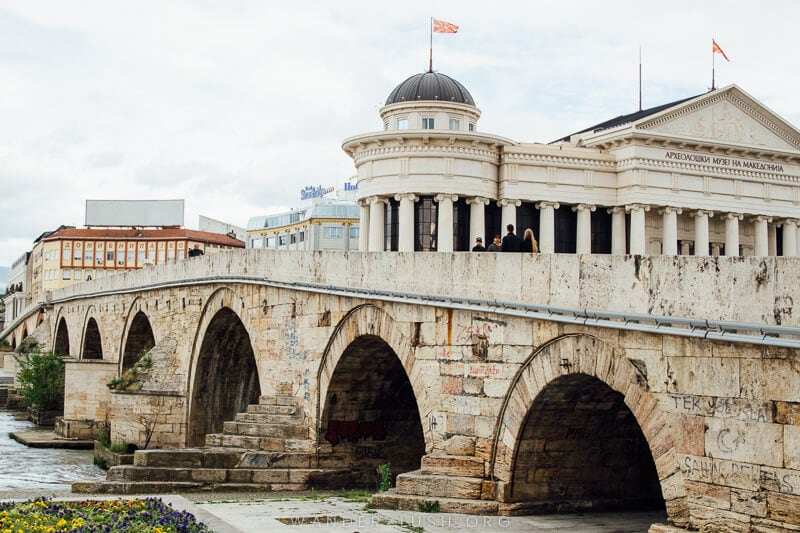
Stone Bridge
Skopje’s Stone Bridge is one of the city’s most iconic landmarks and serves as the gateway to the Old Bazaar. The market area opens up at the northern end of the bridge, just past the public square and Monument of Saints Cyril and Methodius.
Enter the Old Bazaar the same way traders from the Far East would have – by crossing the grand arched bridge.

Daut Pasha Hamam
Daut Pasha Hamam is the first large structure you come to before crossing Boulevard Goce Delchev to enter the bazaar proper. It’s one of two Turkish bathhouses in Skopje that have been renovated and used as exhibition spaces since the 1950s. (The hammam in Tetovo, just west of Skopje, is also used as a gallery and so is one of the hammam’s in Bitola.)
Part of the National Gallery of Macedonia, Daut Pasha Hamam is devoted to contemporary art. At the time of our visit, an exhibition of graphic posters was on display.
Whatever happens to be on show, it’s worth paying the 50 MKD entrance fee just to see the interior architecture of the hamam itself. Plaster arches and wall cornices, as well as the lofty stone domes and marble floors, have all been beautifully restored.
The cavernous space is truly magnificent – and on a hot Skopje day, it’s a few degrees cooler inside the hamam than out. When you’re finished inside, get a nice view of the hamam’s led domes by climbing the stairs opposite SEE University.
Skenderbeg Monument
It’s not strictly part of the Old Bazaar, but the Skenderbeg Monument is worth a short detour, especially if you like Socialist-style mosaics. The monument itself, which depicts the Albanian military hero atop his stallion (the same pose he strikes in Prishtina) is set in a plaza underneath the stairs, just east of the hamam.
An intricate mosaic serves as a backdrop to the statue, and more mosaic panels can be found in the underpass that connects visitors to the main part of the Old Bazaar.


Snack time at Destan, Skopje’s oldest restaurant
Destan has been serving customers since 1913, making it Skopje’s oldest restaurant. The menu is typical Balkan fare – kjebapčinja (cevapi) served with kaymak, chopped onion and peppers, shopska salad topped with cheese, and heapings of bread.
Destan is located at the first main intersection inside the Bazaar and is impossible to miss. The outdoor seating area is perfect for people watching – but be warned, it does get crowded and a touch claustrophobic at lunch time.
Kapan An
Just north of Destan, Kapan An is the first han (Ottoman inn or caravanserai) you come to as you enter the Skopje Old Bazaar. The entrance is a bit hidden – first find Turist Grill (a popular restaurant that’s always overflowing) and take the short flight of stairs next to the entrance down into the han.
Kapan An is in relatively good nick and still used today – upstairs there’s a school, and in the courtyard downstairs there are a few tea rooms and restaurants.
We ate a traditional meal in the courtyard at Restaurant An, the biggest eatery inside the inn. Their tavče gravče (Macedonian-style baked beans) was the best rendition of the dish we had in Skopje.
If you want to sit somewhere quiet and less touristy, Restaurant An is a great alternative to Destan and Turist Grill.

Chifte Hamam
Chifte Hamam is the Old Bazaar’s second bathhouse-cum-gallery. Entrance costs 50 MKD and it’s well worth a look inside.
Antique shops
Murat Pasha Mosque is located in a small square adjacent to Chifte Hamam. Directly opposite, you’ll see two particularly lovely souvenir shops.
Just behind the mosque is an alleyway dedicated to antique shops. It stands out from the rest because of the sheer quantity of curios out on display.
Paintings, silverwear, trunks overflowing with textiles and all sorts of antiques are on show. I walked down the street no less than three times and every time I did, the friendly owner of one shop gave me a demonstration of how his antique coffee grinder works!
There are also huge collections of coins and military memorabilia – if you’re into that sort of thing. Even if you’re not in the market for a take-home, these are some of the most interesting shops to rifle through.

Kujundjiska, ‘Gold Street’
Like Hanoi’s Old Quarter and Sarajevo’s Bascarsija, every street in Skopje Old Bazaar was named after the craft or product traded there. Kujundjiska, ‘Gold Street’, is the last street where shopholders still sell the namesake goods – in this case, gold jewellery.
When asked why Kujundjiska hasn’t gone the way of other streets in the Old Bazaar, which have slowly been transformed into cafes, bars and shops selling everything and anything, our walking tour guide told us simply that gold never goes out of fashion.
Families in Skopje still gift gold to mark life milestones (weddings, births, etc.), so the jewellers on Kujundjiska still do good business, even in this age of online shopping.


Turska baklava Angela Merkel
There are loads of sweets shops and bakeries inside Skopje Old Bazaar, but this one takes the cake.
The Macedonian-Turkish patissier responsible for concocting the delicious desserts sold at this hole-in-the-wall bakery on Gold Street is a big fan of the German Chancellor – so much so that she named her signature dish, Turska baklava, in Merkel’s name.
Photos and newspaper clippings of the Turkish president plaster the shop walls. Whatever your political beliefs, her walnut baklava (45 MKD a piece) is mighty delicious!


Visit Iljco Trajkovski, Skopje’s last hatter
Just over the road from the bakery is a little hat shop. When I poked my head inside, the owner, Iljco, was busy at work, stitching on his Singer machine.
He welcomed me inside and over a cup of Turkish coffee (his shout), told me all about his career as a third-generation hat maker – one of the last remaining craftspeople working inside Skopje Old Bazaar.
Iljco is an incredibly talented craftsman and one of the friendliest people I met in North Macedonia. If you drop by his shop, I’m sure he’ll welcome you inside, too, and give you a tour of his workspace and antique collection.
Suli An
Finished in the 15th century, Suli An (also nicknamed the ‘Water Inn’ for its proximity to the river) is another trader’s accommodation inside the Old Bazaar. Like most other buildings in the area, Suli An was almost completely destroyed in the earthquake that struck Skopje in 1963 and had to be completely reconstructed.
Today, the two-storey han houses the Museum of the Skopje Old Bazaar. This is a great place to learn about the history of the bazaar.
Displays of archaeological materials trace the development of the marketplace back to the 10th century when the nearby fortress also appeared. Contemporary exhibits explore Skopje’s handicraft heritage and the various arts and crafts practiced by traders inside the Bazaar.
Note that the museum has very short working hours – it’s closed by 2pm on weekdays, and doesn’t open at all on weekends. Entrance costs 2 Euro.

Hotel Arka, for the best views of the bazaar
Hotel Arka is a great place to stay if you want to wake up inside Skopje Old Bazaar. Even if you’re not a guest of the hotel, I recommend stopping off for a short break at the Arka cafe.
Located on the seventh floor, the cafe offers excellent panoramic views of the Old Bazaar, including a bird’s eye over the nearby Suli An han. You can better appreciate the shop architecture and layout of the streets from up high.
Prices at the cafe are very reasonable (we paid just over 3 Euro for two macchiatos) and staff are friendly. I recommend choosing a table on the back terrace or upstairs terrace if rather than sitting by the pool.


Bit Pazar, Skopje’s biggest green market
When you reach the northern end of the Old Bazaar, just past Hotel Arka, exit through the small stone gate and cross the road to reach the Bit Pazar.
Skopje’s largest and oldest green market is a separate entity from the Old Bazaar; but the way vendors and shoppers blend across both spaces makes it feel like one almost-cohesive unit.
The Bit Pazar (Turkish for ‘Flea Market’) is a hodgepodge of tarpaulin-covered and open-air stalls. Don’t be put off by the first section, which is all apparel and cheap Chinese plastics – the good stuff, the fruit and veg, spices, nuts and loose leaf tobacco, is a little deeper inside.
For more inspiration, check out these fantastic photos of the Bit Pazaar.

Mustafa Pasha’s Mosque
The proximity of Skopje’s largest mosque to the Old Bazaar is a reminder of just how well-considered and user-friendly Ottoman city planning was. All of a citizen’s needs – trading, praying, bathing and sleeping – could be satisfied within the space of a few dozen square metres.
Mustafa Pasha’s Mosque is located within the confines of the Old Bazaar. To reach it from the Bit Pazar, you’ll need to pass by Kurshmuli An, the final of the three hans in the area. Sadly, this one is in complete disrepair. It was cordoned off at the time of my visit; the best I could do was take a peek at the han from the gate on Atanas Babata street.
The mosque, by contrast, was recently restored to its former 1492 glory. Constructed from white marble, the interior and exterior domes are decorated with delicate blue motifs, giving the appearance of fine porcelain.

It’s free to visit the mosque outside of prayer times. When we showed up 15 minutes before afternoon prayers, a group of men who had gathered in the garden warmly welcomed us inside.
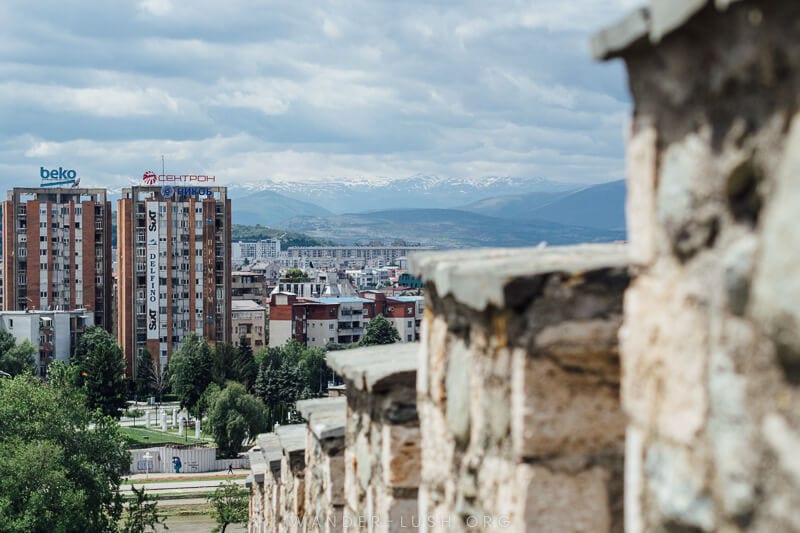
Skopje Fortress
Skopje Fortress (otherwise known as Tvrdina Kale) isn’t strictly part of the Old Town; but it’s so close, you’d be silly not to pop in while you’re in the neighbourhood.
The fortress dates back to the 6th century but was only excavated in recent years (for this reason, parts of the complex are still under rehabilitation, including the two small museums).
For now, visitors have free-reign to walk around the fortress on paths marked out with steel walkways and stairs.
Unfortunately, the eastern wall was closed for maintenance at the time of our visit, so we didn’t get to see if the views of the Old Bazaar are as good as those from Hotel Arka. The panorama of ‘new’ Skopje from the western wall and ramparts is very impressive.


We happened to be there on the day Pope Francis held a public mass in Skopje. Seeing snipers stationed in the fortresses bastions – balancing their barrels in the thin arrowslits where archers in days gone by would have held their posts – was quite a trip!
The fortress is open from 8am until 7pm daily. Entrance is free.
Church of the Ascension of Jesus
Just outside the fortress’s eastern gate is a little Orthodox church hidden behind a tall stone wall and a heavy oak door.
Built in the 16th century when Skopje was under Ottoman rule, the Church of the Ascension of Jesus stands out from other churches in the area. Having to comply with city planning rules at the time, which dictated that no place of worship could be taller than the minaret of Skopje’s main mosque, the architects went down instead, creating a ‘sunken’ three-nave church that is accessed by taking a short flight of stairs underground.
This design feature helped to hide the church from the street outside. It’s very easy to miss – look out for the wooden bell tower just visible over the top of the wall.

Beers at Plivnica Stari Grad
North Macedonia’s first craft brewery operates two bars in Skopje, one in the CBD and another at the foot of the fortress, directly opposite the church. Run by the Temov family, Plivnica Stari Grad specialises in natural and unfiltered craft beers.
A minimum of 10 Bavarian-style pilsners and IPAs are on tap at all times (including seasonal varieties such as ginger, lemon and pumpkin). They also offer light meals.
Enjoy a glass or two (or indeed a tasting tray) in the outdoor courtyard, which is often filled with the sounds of live acoustic music.
Nightcap on ‘Rakija Street’
If you exit the brewery the back way, you’ll find yourself on Jorgandziska – a pitched street that runs north-south to connect back with Podragje. Follow the steps all the way down and you’ll find yourself at the beginning of the market, where this walking tour started.
I’m nicknaming Jorgandziska ‘Rakija Street’ because of the sheer number of bars! Every shop peddles local wine and rakija, the famous Balkan spirit that’s wildly popular across the region.
In North Macedonia, rakija is commonly made from grapes with anise added for sweetness. A glass of Tikves rakija is the perfect way to end your walking tour of Skopje Old Bazaar. Just remember, it’s customary to slowly sip rakija rather than shoot it!

Skopje Old Bazaar walking tour map
Use this Google Map to plan your own walking tour of the Old Bazaar Skopje.
Guided tours of Skopje
Prefer to visit the Old Bazaar in Skopje with a local guide? These walking tours all visit the Old Bazaar.
Where to stay near Skopje Old Bazaar
The Skopje Old Bazaar area is a great place to stay if you want to be right in the heart of the action. You’ll have the Old Bazaar (and all its restaurant offerings) right on your doorstep – plus the ‘other side’ of Skopje is walking distance away.
Hotel Arka is a good mid-range choice. As mentioned, the view of the Bazaar from the hotel bar is fantastic. Hotel Aen is located in the centre of the Old Town and features modern rooms set in a historic building.
For a luxury option, Stone Bridge Hotel is set at the foot of the Stone Bridge on the market side of the river. The indoor pool is a big bonus if you’re visiting Skopje during summer.
More markets to visit in the Balkans
- If you’re continuing through North Macedonia, Bitola and Krusevo also have beautiful Old Bazaars
- Sarajevo bazaar, the marketplace that defines Bosnia and Herzegovina’s capital
- Bucharest’s Plaza Obor, the biggest green market in the Romanian capital
- Prishtina Bazaar, a weekly market in Kosovo’s capital
- Gjirokaster and Berat‘s UNESCO-Listed Old Bazaars in Albania
DIY Walking Tour of Skopje Old Bazaar: Pin it!


Quite the best blurb on Skopje I’ve read. I’m in the middle of a month long stay in this quirky city. Getting lost is something at which I excel. I’m an NZ citizen, on an Australian aged pension (only income) and have been wandering for the last 17 yrs – mostly in eastern Europe and Nepal/Asia which are affordable. Just been to the honey festival in Skopje – last day today.
Great, Glen! I would love to return to Skopje some time. Enjoy!
Hey! Thanks for these details-where can we find the honey from the honey land doc?? Thanks
I’m not sure sorry, Izzy! If you find out, please drop back and let us know!